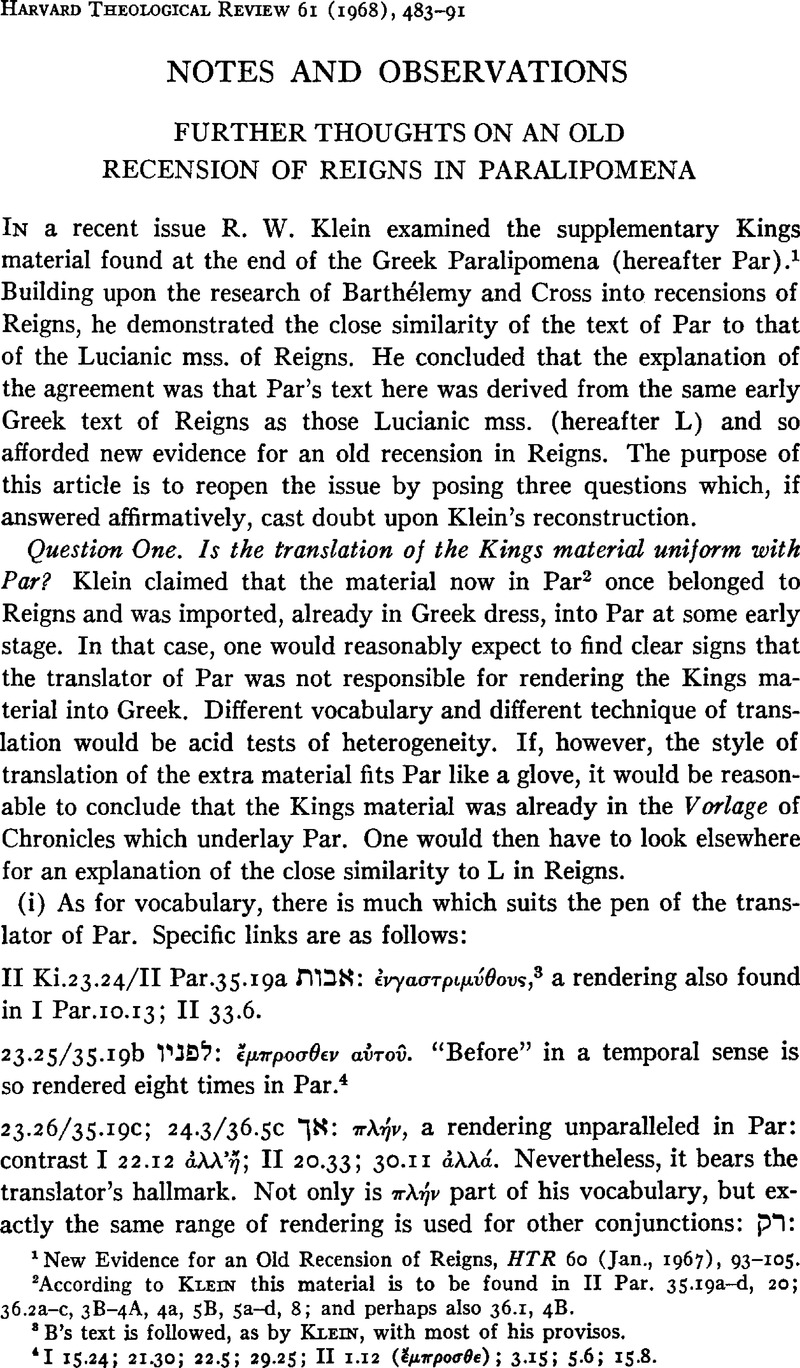No CrossRef data available.
Article contents
Further Thoughts on an Old Recension of Reigns in Paralipomena
Published online by Cambridge University Press: 10 June 2011
Abstract

- Type
- Notes and Observations
- Information
- Copyright
- Copyright © President and Fellows of Harvard College 1968
References
1 New Evidence for an Old Recension of Reigns, HTR 60 (Jan., 1967), 93–105Google Scholar.
2 According to Klein this material is to be found in II Par. 3S.19a–d, 20; 36.2a–c, 3B–4A, 4a, 5B, 5a–d, 8; and perhaps also 36.1, 4B.
3 B's text is followed, as by Klein, with most of his provisos.
4 I 15.24; 21.30; 22.5; 29.25; II 1.12 (ἔμπροσθε); 3.15; 5.6; 15.8.
5 Cf. Barthélemy, D., Les devanciers d'Aquila (1963), 41f.Google Scholar
6 B reads βασιλέως an error absent from the rest of the mss. BH3 wrongly posits ךӜמ … ךלמיו.
7 The reconstruction in BH3 is unlikely, to say the least.
8 BH3 wrongly posits שיא–לכ.
9 It is also used for לעמ II 26.18; 29.6; 30.7; and for עשפ II 21.8, 10.
10 Art. cit., 103, note 38.
11 In I 12.22 רודג was read, and transliterated γεδδουρ.
12 Cf. Lam.1.15 הלם: εξῆρεν. Rehm, M., Textkritische Untersuchungen zu den Parallelstellen der Samuel-Königsbücher und der Chronik (Alttestamentliche Abhandlungen xiii, 3) (1937), 48Google Scholar, posited a less likely םחולכל.
13 E.g., for םירחה, תיחשה, דימשה.
14 In this verse too אלה is rendered in Reigns and Par οὐκ ὶδού, a standard translation in Par, and indeed in the LXX generally (H. St. J. Thackeray, A Grammar of the OT in Greek according to the Septuagint [1909], 125f.). Klein, art. cit., 95, note 12, wrongly suggested a slightly different Vorlage םנה–אלה for מה–אלה.
15 Rehm, op. cit., 48, wrongly posited םיצרק and explained the relation to םיצקש in Kings MT as due to a ש/ר error. Seeligmann, I. L., The Septuagint Version of Isaiah (1948), 66Google Scholar, has rightly seen in Kings MT “a theological correction of an earlier word.”
16 From αβες* via αβαις* (IC/K)? For another example see note 11.
17 B* is corrupt here, reading ἐπ᾽ αὐτοῦ under the influence of ἀπ᾽ αὐτοῦ in v.5a.
18 MT םלשוריו. είς Ιερουσαλημ shows that the conjunction was not read.
19 Ziegler, J., Beiträge zur Jeremias-Septuaginta (1958), 47Google Scholar, has drawn attention to the rendering ἐξαποστελῶ for יחדבאה in Jer.49.38/25.18. He does not cite Par, but he compares Ezek.28.16 ךדכאו; καὶ ἤγαγέ σε and Dan.2.12 LXX הרבוהל: ἐξαγαγεῖν, and asks whether the LXX knew of another root דבא. The rendering here in Par raises the same question; it reflects a similar tradition.
20 Note also II 28.24 םיהלאה–חיב ילכ–חא: αὐτά The retroversion of BH3 into םחוא is doubtful.
21 Studies in the Septuagint II. Chronicles (1946), 35.
22 Read by A, etc. B is corrupt.
23 Rehm, op. cit., 27f.
24 W. Rudolph, Chronikbücher (Handbuch zum AT) (1955), ad loc.
25 Wutz, F., Die Transkriptionen von der LXX bis zu Hieronymus (1925), 30Google Scholar; Rehm, op. cit., 72.
26 I 22.13; 29.19; II 7.17; 19.7; 33–8; 34–31.
27 Noth, M., Die Israelitischen Personennamen im Rahmen der Gemeinsemitischen Namengebung (1928), 260.Google Scholar
28 By a Δ (= ד for ר)/Λ error or by assimilation to the preceding Σελλην?
29 Op. cit., 2–12.
30 Op. cit., 37.
31 In v.3 םירצמ–ךלמ והריםיו was inserted and vv.6, 7 were also added. In V.4 םירצמ אביז חקל זחאוהי–תאו was replaced by המירצמ והאיביו וכנ ׳ל זחאו י–תאו.
32 Art. cit., 105, note 42.
33 Cf. the error βασιλέως Ιουδα in II 36.4 taken over in IV Rg.23.34 R. It is significant that in IV Rg.24.20, where no parallel exists in Par, L R read ἐπὶ τὸν θυμόν for ףא–לע in v.3 R so reads, but L has θυμός, clearly by assimilation to Par. It may well be that Par has in turn suffered some early assimilation to Reigns. γνώστας for םינעדי in 35.19a does not accord with ἐπαοιδούς in 33.6, where Par, as so often, echoes the Pentateuch (Lev.19.31; 20.6, 27); γν occurs in I Rg.28.3, 9; IV 21.6 L R.
34 Much use has been made in this article of material drawn from the author's doctoral thesis approved by London University.




